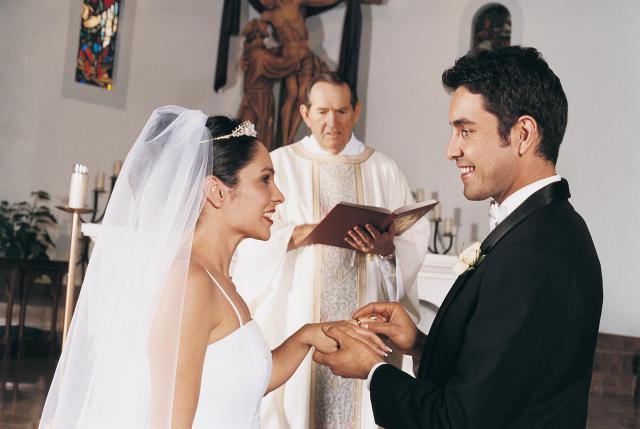Intermarriage: how to do if you are Christians but do not want to join the Catholic Church.

![dv1439002[1]](http://www.veritadellabibbia.net/wp-content/uploads/dv14390021-150x150.jpg) mixed couples? Problems to celebrate a wedding? A future spouse refuses the Catholic Church? No problem, you can celebrate a mixed marriage between an interfaith partners who intends to remain tied to Catholicism (Catholic) and the other believed to Christian (Protestant) but rejects the Catholic Church, the sacraments, Confirmation, the marital courses, etc.
mixed couples? Problems to celebrate a wedding? A future spouse refuses the Catholic Church? No problem, you can celebrate a mixed marriage between an interfaith partners who intends to remain tied to Catholicism (Catholic) and the other believed to Christian (Protestant) but rejects the Catholic Church, the sacraments, Confirmation, the marital courses, etc.The text that follows is both the site of the Waldensian Church and in the Vatican: is an agreement between the two parties in the event of interfaith marriage.
Indications for the procedures related to the celebration of an interfaith marriage
In the event of the celebration of an interfaith marriage (or mixed, according to Catholic terminology) which is recognized by both churches, directions to follow are the following:
1. The engaged are first of all invited to take an in-depth awareness of the value of a marriage lived in the Lord, and the different meaning that their membership churches give it.
2. After mature reflection engaged couples decide in which of the two churches intend to celebrate their marriage. Will meanwhile take along contact with both the pastor with the pastor with a view to proper preparation of their wedding.
3. The Catholic side will turn to their parish priest for the completion of the procedures required and transmit the documents required. The pastor will address questions in order to obtain the license for the celebration of a mixed marriage. If the couple had decided the celebration in the evangelical church, the Catholic party will also have to obtain a dispensation from the canonical form. The part evangelical remain meanwhile in touch with your pastor for the clarifications and need know about the church's position.
4. In his conversation with the pastor of the Gospel is not bound to any particular performance, not being in any way subject to canonical provisions, with the exception of the delivery of a baptismal certificate (released by his own pastor) e, possibly, of a certificate of free status (issued by the Municipality), where the pastor does not reach awareness of the absence of a previous marriage in a different way.
5. The Catholic side is held, in front of the parish priest, to sign a declaration in which he undertakes to “remove the dangers of abandoning the faith” and to promise “to do everything in his power to ensure that all children are baptized and educated in the Catholic Church”. By assuming these commitments, the Catholic party is aware that the evangelical partner is the bearer of an authentic Christian faith and, regarding any children, has the same rights and duties with regard to their baptism and their religious education. The evangelical part is also required to take note of the declaration of the Catholic partner, without membership obligation. This acknowledgment can be made with a verbal declaration, without obligation to sign.
6. The parish priest is required to ensure that both married couples do not exclude the one who, with canonical terminology, they are defined “nature, essential purposes and properties of marriage” (unit, indissolubility, procreation) and that the Document of the Waldensian Synod on marriage, defines how “stable community of life, open to the possible formation of a family”.
7. The pastor, after having fulfilled the aforementioned procedures, he addresses the request for a license to the Curia (and eventually) canonical form of dispensation, for the celebration of a mixed wedding. While the Catholic side will have to go to the Curia, this obligation is not required of the evangelical part.
8. The request for marriage banns from the Civil Status Officer must specify whether it is the celebration of a “concordat marriage” (if it is done in a Catholic church) or a “marriage according to the Waldensian system – Art. 11 Law 449, 1984 – (if it is made in the Waldensian church).
9. The celebration will take place in the church chosen by the couple according to the liturgy proper to that church. There is no place “concelebration”, but she can be invited to the celebration (if the bride and groom so wish) a representation of the other church for possible participation in the liturgy (biblical reading, prayer, message). If the celebration takes place in the Catholic Church there will be no Eucharistic liturgy.
10. The couple is invited to be active in both communities in order to foster dialogue, confrontation and encounter in a spirit of fraternal research. It will remain strongly rooted in the faith of the one Lord and Redeemer. Jesus Christ. This will be the strength and basis of their union beyond the confessional differences of the churches to which they belong.
11. The couple will also try to maintain contact and relationships with other couples who live in the same situation, favoring and promoting regular meetings of interfaith couples, in the presence of a representative in charge of the two communities, in order to continue the research and deepen and clarify the problems related to his condition, in particular with regard to baptism and the religious education of children.
Reference texts
The document of the Waldensian Synod on marriage, 1971, paragraphs V to VII. The general decree on canonical marriage, of the Italian Bishops' Conference, 1990, paragraphs 47-52 The common text of study and proposal for a pastoral approach to interconfessional marriages, 1993
The document of the Waldensian Synod on marriage, 1971, paragraphs V to VII. The general decree on canonical marriage, of the Italian Bishops' Conference, 1990, paragraphs 47-52 The common text of study and proposal for a pastoral approach to interconfessional marriages, 1993